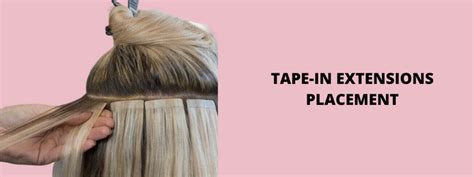Extensions have emerged as a transformative beauty tool, allowing individuals to effortlessly achieve voluminous, flowing hair. However, the journey to flawless extensions requires a crucial element: tape for extensions.

Understanding Tape for Extensions
Tape for extensions is a specialized adhesive strip that acts as the anchor between the natural hair and the extension strands. Its primary purpose is to provide a secure and discreet bond, ensuring that the extensions blend seamlessly with existing hair.
Types of Tape for Extensions
There are two main types of tape for extensions:
- Double-Sided Tape: Consists of two adhesive surfaces, one facing the natural hair and the other facing the extension strand.
- Single-Sided Tape: Features a single adhesive surface that is applied to the extension strand and then pressed onto the natural hair.
Benefits of Tape for Extensions
Harnessing the transformative power of tape for extensions can unlock a myriad of benefits for hair enthusiasts:
Secure Bonding
Tape for extensions forms an incredibly strong bond between the natural hair and the extensions, ensuring longevity and stability. Extensions installed with tape can withstand styling, brushing, and everyday activities without compromising their integrity.
Discreet Application
Tape for extensions is virtually invisible when applied correctly, creating a seamless transition between natural hair and extensions. This discrete nature allows for a natural, flawless appearance.
Long-Lasting Performance
Tape for extensions offers exceptional durability, with an average lifespan of 6-8 weeks. Regular maintenance appointments are recommended to ensure optimal performance and prevent slippage.
Versatility
Tape for extensions can accommodate various hair types and textures, including thin, thick, curly, and straight hair. This versatility makes it suitable for a wide range of individuals seeking voluminous, replenished locks.
Comfort and Flexibility
Unlike other extension methods, tape for extensions does not put any tension or weight on the natural hair. This comfort and flexibility allow for natural, effortless movement and styling.
Selecting the Right Tape for Extensions
Choosing the appropriate tape for extensions is crucial to ensure optimal performance and hair health. Consider the following factors when making a decision:
- Hair Type: Different tape formulas are designed for specific hair types. Consult with a professional stylist to determine the best tape for your hair’s texture and condition.
- Bonding Strength: Choose tape with sufficient adhesive strength to withstand everyday activities and styling without slipping.
- Visibility: Opt for tape that blends seamlessly with your hair color to achieve a natural, discreet appearance.
Application of Tape for Extensions
The precise application of tape for extensions requires precision and expertise. Typically, the process involves the following steps:
- Hair Preparation: Ensure the hair is clean, dry, and free of any products or oils.
- Sectioning: Divide the hair into sections to facilitate the application process.
- Tape Application: Apply a small strip of tape to the natural hair, close to the scalp but not touching it.
- Extension Placement: Place the extension strand onto the tape and press it firmly to create a secure bond.
- Sealing: Use a heat tool or sealing agent to enhance the bond and prevent slippage.
Maintenance and Removal of Tape for Extensions
Maintaining tape-on extensions requires regular upkeep to ensure their longevity and prevent damage to the natural hair.
Maintenance Tips
- Regular Brushing: Brush extensions gently with a wide-tooth comb to prevent tangles and maintain their smoothness.
- Avoid Heat: Minimize the use of heat styling tools on extensions to prevent adhesive softening and slippage.
- Avoid Products with Oils: Avoid using hair care products containing oils or conditioning agents, as these can weaken the adhesive bond.
- Professional Checkups: Visit a stylist every 6-8 weeks for maintenance appointments to adjust extensions, retighten the bonds, and protect the natural hair.
Tape Removal
Removal of tape-on extensions should be performed by a professional stylist to minimize damage to the natural hair. The stylist will use a specialized tape removal solution to gently dissolve the adhesive bond and separate the extensions from the hair.
Troubleshooting Tape for Extensions
Occasionally, minor issues may arise with tape for extensions. Here are some common problems and their solutions:
- Slipping: If extensions are slipping, use a stronger tape or consider a different tape formula.
- Tangling: Detangle extensions regularly with a wide-tooth comb and avoid using products that can lead to tangling.
- Irritation: If irritation occurs, remove extensions immediately and seek professional assistance.
Conclusion
Tape for extensions has revolutionized the world of hair extensions, offering a secure, discreet, and versatile solution for achieving voluminous, flowing locks. By understanding the different types of tape, selecting the right tape for your hair type, and following the correct application and maintenance techniques, you can harness the transformative power of tape for extensions to enhance your hair and elevate your style.
FAQs
1. How long do tape-on extensions last?
Tape-on extensions typically last for 6-8 weeks with proper maintenance and care.
2. Are tape-on extensions damaging to my natural hair?
When applied correctly and maintained properly, tape-on extensions are minimally damaging to natural hair.
3. Can I swim or shower with tape-on extensions?
Yes, you can swim or shower with tape-on extensions, but it is important to follow proper maintenance instructions to prevent slippage or damage.
4. How often should I get my tape-on extensions maintained?
Professional maintenance appointments are recommended every 6-8 weeks to ensure optimal performance and prevent slippage.
5. Can I cut and style tape-on extensions?
Yes, you can cut and style tape-on extensions, but it is recommended to consult with a professional stylist for guidance to avoid damage.
6. How do I remove tape-on extensions?
Tape-on extensions should be removed by a professional stylist using a specialized tape removal solution to minimize damage to the natural hair.
